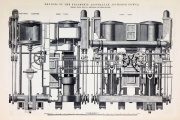

of Norton Road, Stockton-on-Tees
1855 George Blair was appointed manager of engine maker Fossick and Hackworth
1865 in the spring Blair was made a partner and the company became Fossick, Blair and Co when Hackworth retired.
Around 1866 the company became Blair and Co. George Blair was responsible for the expansion of the works to specialise in marine engines. At this time the company had 700 employees (later to rise to 2,000) and covered an area of seven and a half acres.
1869 The first compound marine engine on the Tees was built by Blair's in January and fitted to the "Glenmore" built by Backhouse and Dixon.
1869 Engines for SS Australian. [1]
1884 the company produced its first triple expansion engine for the "Burgos" built by Richardson, Duck and Co.
1887 the sheerlegs, which were to become a Stockton landmark for many years were errected at a cost of £2,695. These shearlegs were capable of lifting up to 100 tons and were sighted near the river to lift marine engines into newly built ships.
1899 See 1899 Shipbuilding Statistics for details of production this year.
1900 The company was registered on 28 June, in reconstruction of a company of the same title, to take over a business of marine engineers. [2]
By 1914 almost 1,400 marine engines had been built. At least 340 for Pearse and later Ropner, 240 for Richardson, Duck and Co and 103 for Thomas Turnbull at Whitby. A total of 75 engines were built during the First World War.
1914 Directory: Listed as Marine Engineers. [3]
1919 The company was taken over by Gould Steamships and Industrials which was in turn wound-up in 1926[4].
See Also
Sources of Information
- [2] Wreck Site

